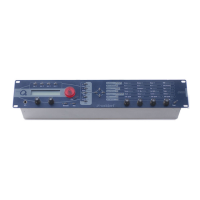Sound Parameters – Filter Section
75 Waldorf microQ User´s Manual
You can bring more movement into the sound by modulating the cutoff frequency via the LFOs, the
envelopes or the Keytrack parameter of the filter. At a value of 64 and a Resonance value of 114, the
filter oscillates with 440Hz, which is equal to A3 (the Comb+ type oscillates one octave higher).
Tuning is scaled in semitone steps. When Keytrack is set to +100%, the filter can be played in a
tempered scale.
Keytrack -200%…+197%
Determines how much the cutoff frequency depends on the MIDI note number. The reference note
for Keytrack is E3, note number 64. For positive settings, the cutoff frequency rises on notes above the
reference note, for negative settings the cutoff frequency falls by the same amount, and vice versa. A
setting of +100% corresponds to a 1:1 scale, so e.g. when an octave is played on a keyboard the
cutoff frequency changes by the same amount. If you want to play the filter in a tempered scale, e.g.
for a solo sound with self-oscillation, set the value to +100%. On most bass sounds lower settings in
the range +50…+75% are optimal to keep the sound smooth at higher notes.
Resonance 0…127
Controls the emphasis of the frequencies around the cutoff point. Use lower values in the range of
0…80 to give more brilliance to the sound. At higher values of 80…113 the sound gets the typical
filter character with a strong boost around the cutoff frequency. When the setting is raised to values
above 113, the filter starts to self-oscillate, generating a pure sine wave. This feature can be used to
create analog-style effects and percussion-like electronic toms, kicks, zaps etc.
Drive 0…127
Determines the amount of saturation that is added to the signal. If set to 0, no saturation will be added
or, in other words, the signal will remain clean. Lower values will add some harmonics to the signal,
resulting in a warm character. Increasing the value will bring in more and more distortion, suitable for
harder lead sounds and effects.
Env (Filter Envelope Amount) -64…+63
Determines the amount of influence the filter envelope has on the cutoff frequency. For positive
settings, the filter cutoff frequency is increased by the modulation of the envelope, for negative
settings, the cutoff frequency is decreased. Use this parameter to change the timbre of the sound over
time. Sounds with a hard attack usually have a positive envelope amount that makes the start phase
bright and then closes the filter to get a darker sustain phase. String sounds, on the other hand, usually
use a negative envelope amount that gives a slow and dark attack before the cutoff rises in the sustain
phase.
Velocity (Filter Velocity) -64…+63
Determines the amount of influence the filter envelope has on the cutoff frequency, based on key
velocity. This parameter works similarly to the Env parameter with the difference that its intensity is
velocity based. Use this feature to give a more expressive character to the sound. When you hit the
keys smoothly, only minimal modulation is applied. When you hit them harder, the modulation
amount also gets stronger. The following picture illustrates the functionality of this parameter:

